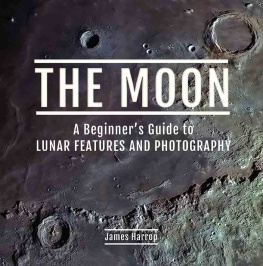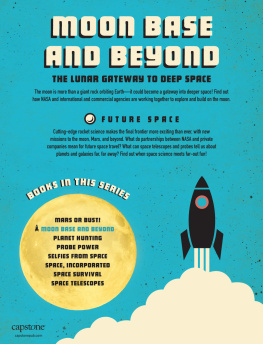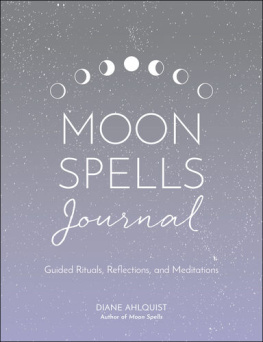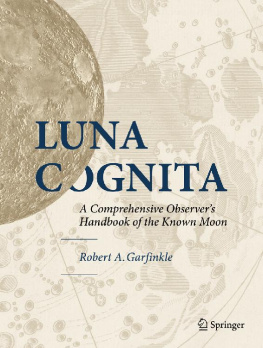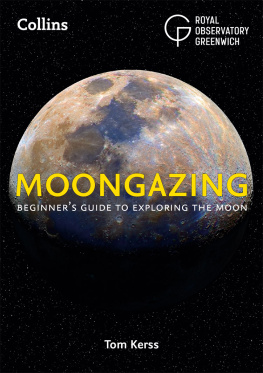
THE MOON
A Beginners Guide to
LUNAR FEATURES AND PHOTOGRAPHY
THE MOON
A Beginners Guide to
LUNAR FEATURES AND PHOTOGRAPHY
James Harrop
First published in Great Britain in 2020 by
White Owl
An imprint of
Pen & Sword Books Ltd
Yorkshire Philadelphia
Copyright James Harrop, 2020
ISBN 9781526760586
ePUB ISBN 9781526760593
Mobi ISBN 9781526760609
The right of James Harrop to be identified as Author of this work has been asserted by him in accordance with the Copyright, Designs and Patents Act 1988.
A CIP catalogue record for this book is available from the British Library.
All rights reserved. No part of this book may be reproduced or transmitted in any form or by any means, electronic or mechanical including photocopying, recording or by any information storage and retrieval system, without permission from the Publisher in writing.
Designed by Paul Wilkinson
Pen & Sword Books Ltd incorporates the Imprints of Pen & Sword Books Archaeology, Atlas, Aviation, Battleground, Discovery, Family History, History, Maritime, Military, Naval, Politics, Railways, Select, Transport, True Crime, Fiction, Frontline Books, Leo Cooper, Praetorian Press, Seaforth Publishing, Wharncliffe and White Owl.
For a complete list of Pen & Sword titles please contact
PEN & SWORD BOOKS LIMITED
47 Church Street, Barnsley, South Yorkshire, S70 2AS, England
E-mail:
Website: www.pen-and-sword.co.uk
or
PEN AND SWORD BOOKS
1950 Lawrence Rd, Havertown, PA 19083, USA
E-mail:
Website: www.penandswordbooks.com
The Moon A Beginners Guide to Lunar Features and Photography
Preface
It is a beautiful, delightful sight to behold the body of the moon
G ALILEO G ALILEI
Astronomy has always been a passion of mine, as I have always been fascinated by the majestic objects present all around us in the night sky, many of them going unseen by most people. It was the astrophotography element which revealed this hidden world and I soon became hooked when I realised how much detail could be captured using equipment in the backyard. I started with deeper sky astrophotography but quickly developed an appreciation for Earths closest satellite, the Moon. This lunar neighbour of ours is quite often underappreciated and almost taken for granted as a featureless rock in the sky, but the reality is quite the opposite. As you start observing the Moon, you immediately see a world which you have never seen in such exquisite detail before. The more you view the Moon, the more intriguing the geological diversity and variety of features become. When you view the different craters, seas, mountains, rilles and rays you will discover that there is much more to the Moon than meets the eye.
Capturing these lunar details using modern astrophotography techniques will reveal the exquisite detail of objects which are impossible to view with the unaided eye, and once you master the imaging techniques, it is self-inspiring, educational and overall a great way to learn about photography.
I hope the book will inspire you to take up astronomy and more importantly to try your hand at astrophotography which initially may seem quite daunting, especially with so many technical terms involved in the learning process. Once you understand the terms, the steps involved and the technology, the reality is that even some of the most basic equipment will give you outstanding results.
As well as the photographic aspect, the book will also assist you in navigating the Moon, identifying features and understanding the variations in geology and the formation of different lunar features visible through your telescope, and you will be surprised at the level of detail which your equipment can see. It took a lot of research and trial and error to find a technique which worked for me to capture and process the images in fine detail. Once I started down the route of lunar photography, it quickly became evident that capturing the image is only one aspect of producing a beautiful picture; as image processing also has a significant influence on the outcome.
When learning about lunar astrophotography, I quickly discovered that there was a distinct lack of resources in all areas, including the Moons geological features, the technical aspects of lunar photography and the most challenging of all: image processing. This made it very difficult for me to break into astrophotography. Online resources are available and online forums may be helpful if you have specific questions, but you may find information is quite fragmented and it is not always obvious which are the right questions to ask. The lack of information is one of the main reasons I decided to write this book.
Initially, however, there are some useful resources to consider. For example, you may have a local astronomy shop which would be able to advise you on equipment for observing the Moon within your price range. I found this resource was beneficial and an excellent place to start, although astronomy shops are becoming less common. Another option would be your local astronomy club which would be happy to advise you and potentially lend out equipment for you to test before you purchase your equipment.
The purpose of this book is to provide jargon-free information on all the processes involved in imaging the Moon and I hope it will be invaluable to anyone starting this hobby. This book is aimed at beginners, amateur astronomers or anyone interested in learning about the Moon, and it will provide advice for finding and imaging lunar features. A basic understanding of camera operation and photographic terms is assumed.
The first part of the book provides a general outline of the hobby, including the use of equipment, capturing images, image expectations and image processing which is a very important and sometimes overlooked aspect. I have written the processing steps as an easy-to-follow visual, step by step guide for beginners. Overall the book contains all the information you will need for lunar photography and I hope it will inspire you to get out your camera and telescope and start observing the Moon. The book does not recommend any specific telescopes as it focuses primarily on the photographic aspect. However, most telescopes are suitable for lunar photography and the principles of photography discussed here can be applied to other telescopes. The images in the book were captured using standard equipment.
The second part of this book highlights some of the more popular lunar features and shows you how to find them on the surface, including a few detailed facts about each one. Some of the features are easy to see but others are more challenging. See how many you can find!
I want to express my thanks and gratitude to the people who made this book possible with their support and assistance. I must start by thanking my wife Melanie for her encouragement and patience throughout the whole process, especially with the hours spent behind the telescope! My children Louis and Tom for their dedication and help. A special thanks to Gary Harrop for his excellent eye for details and the time taken to help with my work.
Introduction
Understanding the workings of the Universe is awe-inspiring, especially when you look into the depths of space on a clear night you realise how insignificantly small we are on the grand scale of the Cosmos. You can learn a lot from looking beyond the Earth and observing galaxies, nebulae, planets and our closest neighbour the Moon all show the wonders of nature. As you would probably expect, most of the exquisite detail is hidden from the view of the unaided eye and requires equipment to reveal this hidden world.
Next page
